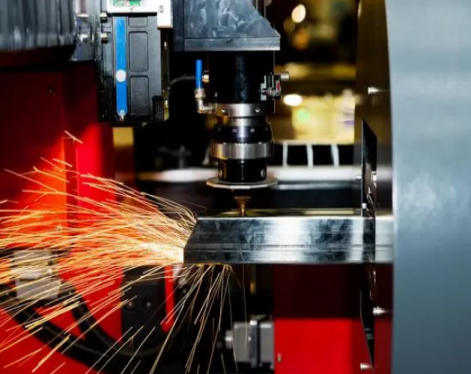Steel plate processing manufacturers have a variety of common processing methods, including laser cutting, plasma cutting, water cutting, shearing, stamping, bending and welding. Each method has its own characteristics and scope of application. Choosing the most suitable processing method can obtain the best processing effect and economic benefits.
1. Laser cutting
Laser cutting is a processing method that uses a high-energy laser beam to irradiate the surface of the steel plate to instantly melt and evaporate the local steel plate and form a cutting mouth. This method has the advantages of high cutting accuracy, good cutting quality, and high processing efficiency. It is widely used in the cutting of thin plates, medium and thick plates, and extra-thick plates.

2. Plasma cutting
Plasma cutting is a processing method that uses a high-temperature plasma arc to melt and blow away the steel plate locally to form a cutting mouth. This method has the advantages of fast cutting speed, good cutting quality, and low equipment cost. It is suitable for thin and medium-thick steel plate processing.
3. Water cutting
Water cutting is a processing method that uses high-pressure water flow to flush and grind the steel plate, cut off the local steel plate and form a cutting mouth. This method has the advantages of high processing accuracy, good cutting quality, and little damage to the parent material, and is suitable for processing steel plates of various thicknesses.
4. Shearing
Shearing is the use of a shearing machine to shear the steel plate to the required size. This method has the advantages of simple processing, fast speed, and low cost, and is suitable for shearing of steel plates of various thicknesses.
5. Stamping
Stamping is the use of a stamping machine to locally roll the steel plate to form the required shape and size. This method has the advantages of high processing accuracy, high production efficiency, and the ability to process complex shapes. It is widely used in the processing of steel plate products in the automotive, home appliance, construction and other industries.
6. Bending
Bending is to bend the steel plate through a bending machine to form the required angle and shape. This method has the advantages of simple processing, wide application range, and high processing accuracy, and is widely used in the processing of steel plate products in various industries.
7. Welding
Welding is to use welding technology to connect two steel plates together to form an integral structure. This method has the advantages of high connection strength and wide application range, and is widely used in the production of steel structures in industries such as bridges, buildings, and ships.
The above are several common steel plate processing methods. Different processing methods have different characteristics and scopes of application. When choosing a steel plate processing method, it is necessary to comprehensively consider the actual needs and product requirements and choose the most suitable processing method to achieve the best processing effect and economic benefits.
Read more: Carbon Steel Plate
1. Laser cutting
Laser cutting is a processing method that uses a high-energy laser beam to irradiate the surface of the steel plate to instantly melt and evaporate the local steel plate and form a cutting mouth. This method has the advantages of high cutting accuracy, good cutting quality, and high processing efficiency. It is widely used in the cutting of thin plates, medium and thick plates, and extra-thick plates.

2. Plasma cutting
Plasma cutting is a processing method that uses a high-temperature plasma arc to melt and blow away the steel plate locally to form a cutting mouth. This method has the advantages of fast cutting speed, good cutting quality, and low equipment cost. It is suitable for thin and medium-thick steel plate processing.
3. Water cutting
Water cutting is a processing method that uses high-pressure water flow to flush and grind the steel plate, cut off the local steel plate and form a cutting mouth. This method has the advantages of high processing accuracy, good cutting quality, and little damage to the parent material, and is suitable for processing steel plates of various thicknesses.
4. Shearing
Shearing is the use of a shearing machine to shear the steel plate to the required size. This method has the advantages of simple processing, fast speed, and low cost, and is suitable for shearing of steel plates of various thicknesses.
5. Stamping
Stamping is the use of a stamping machine to locally roll the steel plate to form the required shape and size. This method has the advantages of high processing accuracy, high production efficiency, and the ability to process complex shapes. It is widely used in the processing of steel plate products in the automotive, home appliance, construction and other industries.
6. Bending
Bending is to bend the steel plate through a bending machine to form the required angle and shape. This method has the advantages of simple processing, wide application range, and high processing accuracy, and is widely used in the processing of steel plate products in various industries.
7. Welding
Welding is to use welding technology to connect two steel plates together to form an integral structure. This method has the advantages of high connection strength and wide application range, and is widely used in the production of steel structures in industries such as bridges, buildings, and ships.
The above are several common steel plate processing methods. Different processing methods have different characteristics and scopes of application. When choosing a steel plate processing method, it is necessary to comprehensively consider the actual needs and product requirements and choose the most suitable processing method to achieve the best processing effect and economic benefits.
Read more: Carbon Steel Plate









